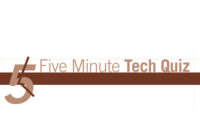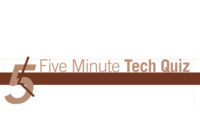a. Image size
b. Compression
c. Frame rate
d. All of the above
e. None of the above
2. Which of the following is an exaple of a video compression technology?
a. JPEG
b. MPEG
c. Wavelet
d. All of the above
e. None of the above
3. 1 Kilobit is equal to 1,000 bits.
a. True
b. False
4. Which of the following is an advantage of using fiber optic cable over copper wire?
a. Higher immunity to EMI
b. Higher bandwidth
c. Longer distances
d. All of the above
e. None of the above
5. Multi-mode fiber optic cable has a higher transmission rate than single mode fiber optic cable.
a. True
b. False
6. Which type of cable should be used to connect a digital TCP/IP camera to an Ethernet network?
a. RG-59U
b. RG-6
c. RG-6 Quad Shield
d. Category 6
e. Any of the above
7. A video compression scheme that discards information which is redundant or unno- ticeable to the viewer is called
a. archival.
b. broadband.
c. loosy.
d. analog.
e. None of the above
8. Intentionally limiting the bandwidth used by remote viewing digital video over a LAN is called throttling.
a. True
b. False
9. A digital signature is used to assure copyright protection.
a. True
b. False
10. An IP address is composed of 4 octets.
a. True
b. False
11. DVRs can allow remote viewing over a
a. LAN.
b. WAN.
c. Internet.
d. Any of the above
e. None of the above
12. Which of the following is an advantage of using digital CCTV over analog systems?
a. Quicker search times
b. Remote viewing and searching
c. Higher quality playback of images
d. All of the above
e. None of the above
13. Video servers can allow analog CCTV cameras to be connected to a network.
a. True
b. False
14. Digital images may be
a. saved to removable storage devices.
b. sent in an email.
c. printed on standard computer printers.
d. All of the above
e. None of the above
Networking video
Analog CCTV systems are slowly being replaced by digital CCTV
systems as the cost per camera is reduced and the proliferation of in-house data networks and availability of the internet becomes more commonplace. To see if you have kept pace with the advances in digital CCTV take the following quiz.

What’s Wrong with This?
Wally agreed to install a network to allow an existing DVR to be remotely viewed by 4 computers. Wally ran category 6 cables from each computer to the DVR and then installed a type 66 punch block to connect these cables to the DVR’s Ethernet connection cable. Wally carefully installed all cables as shown in this diagram, and properly installed crimp on connectors at each computer and the DVR. When the customer’s IT contractor arrived to configure the computers he was not happy with Wally’s work. Can you see what Wally did wrong and what he must do to correct the problem?Answers
1. d – All of these factors as well as the size of the storage media determines the storage capacity of a DVR. Higher image file size and frame rates reduce the storage capacity while better compression techniques can increase it.2. d
3. b – I kilobit equals 1,024 bits or 128 bytes.
4. d
5. b – Single mode fiber not only has a higher transmission rate but also much greater distance than multi-mode fiber.
6. d – Since a TCP/IP camera has a digital output you should use category 5 or better cable. RG-59U and RG-6 are used for analog CCTV cameras.
7. c
8. a – Throttling may be necessary to limit the impact of remote video viewing over a data network. It works by limiting the amount of bandwidth that the CCTV system can utilize, freeing network resources for other tasks.
9. b – Digital signatures are used to ensure that the image was not altered.
10. a
11. d – Depending upon the network configuration and authority level of the user digital images can be viewed from anywhere that has a network connection to the DVR.
12. d
13. a
d – Since digital images are basically computer type files they can be treated in the same fashion as a text file.

Answers to: What's Wrong With This?
Wally’s problem is caused by the way he terminated the cables running to the 4 computers. Unlike typical notification devices, computers on a network, also called nodes, are not simply connected in parallel; you need a device such as a HUB to connect them together.Wally should remove the punch block, install crimp connectors on the cables and install a HUB that has sufficient capacity to handle the DVR and 4 other computers, as shown in this diagram. Once this is accomplished the IT contractor can install the necessary Ethernet cards in each computer and configure them as a LAN (Local Area Network).


